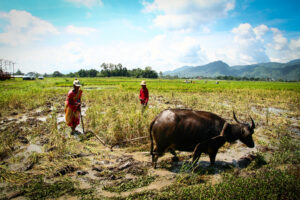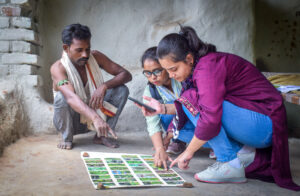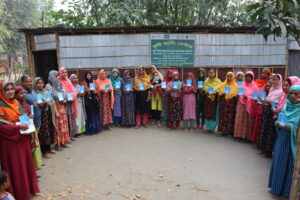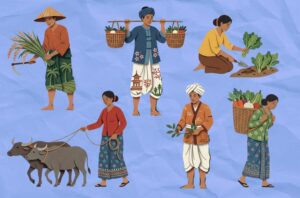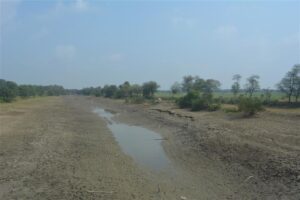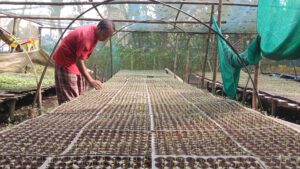Sharif Ahmed and Humnath Bhandari
Agriculture in Bangladesh is predominantly focused on rice, with approximately 75% of arable land dedicated to its cultivation. Farmers in the country cultivate rice up to three times a year, with the rice-rice cropping pattern covering about 27% of the country’s agricultural area. In certain regions, particularly in Northern Bangladesh, this figure can reach as high as 60% (Nasim et al. 2018).
Rice serves as the staple food for the people of Bangladesh, making food security synonymous with ensuring sufficient rice production. To meet the growing demand for rice, the adoption of modern high-yielding varieties (HYV) has increased significantly, with around 90% of farmers currently using these varieties. This shift towards HYVs has also led to a rise in the use of agricultural inputs such as fertilizers, irrigation, and pesticides.
However, Bangladesh’s agriculture faces numerous challenges. These include shrinking arable land, increased climate variability, soil degradation and declining fertility, rising prices of agricultural inputs, and a growing need for diversified food production. One particularly alarming issue is the decrease in soil fertility; if this trend continues without interventions to restore soil health, it could have devastating consequences for food production in the country.
Bangladesh boasts a diverse agroecological landscape, and farmers have adapted their crop production systems to address climate-related risks. In the northern and northwestern regions, where most of the flat land is located, crop production is intensive. In contrast, the southern and southwestern coastal areas face multiple crop production challenges, resulting in a less intensive approach, despite the potential for increased crop intensification. The northeastern region, characterized by low-lying areas known as Haor, primarily grows winter rice (boro), although farmers often contend with flash floods that can damage crops during the maturity stage. The eastern and southeastern parts of the country are hilly, making intensive crop production challenging, but these areas have significant potential for agroforestry and high-value crops.
As the population continues to grow, Bangladesh must enhance its food production while also diversifying food options. This increased production needs to occur on less land than is currently utilized for agriculture. Additional challenges include shortages of chemical fertilizers and declining soil health.
To address both current and future food production challenges, Bangladesh must intensify agricultural practices in certain areas by incorporating diversified crops and innovative cropping strategies.
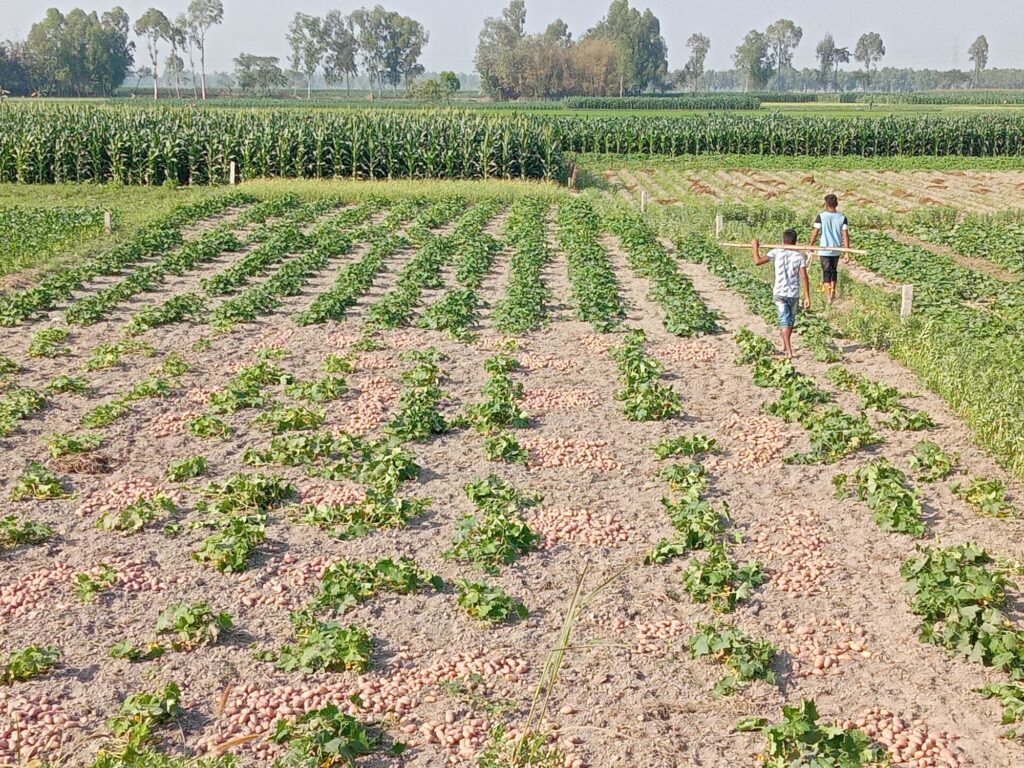
Challenges of crop diversification in Bangladesh
Crop diversification in Bangladesh faces significant challenges due to various agroecological, economic, and socio-cultural constraints. The primary obstacles include the dominance of rice cultivation, small land sizes, subsistence farming, limited mechanization, inadequate market systems, farmers’ mindsets, climate risks, soil conditions, ineffective policies, and issues related to input availability.
Farmers often lack access to knowledge and training about alternative crops, which limits their willingness to adopt new practices. Additionally, limited access to quality seeds, insufficient irrigation for dry-season crops, and a lack of technical knowledge regarding diversified farming hinder the adoption of new methods.
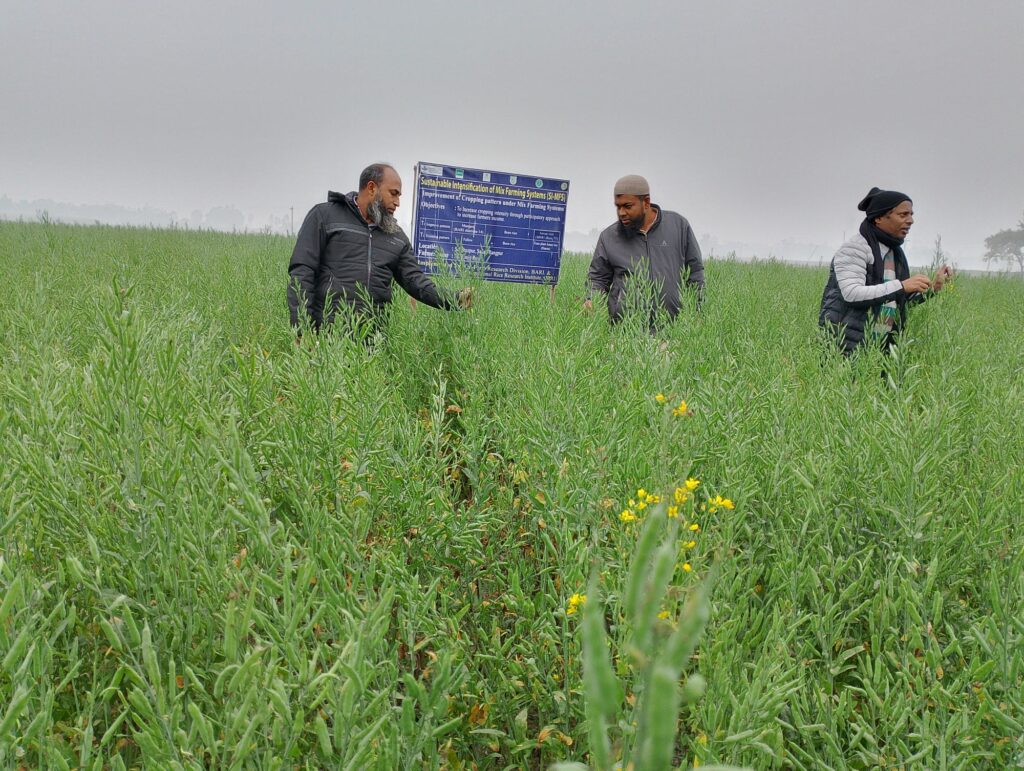
Inadequate infrastructure, including poor transportation networks, further complicates the marketing of diverse crops, leading to financial instability for farmers. Climatic variability also poses a significant risk, as unpredictable weather patterns can impact the viability of non-traditional crops, causing farmers to return to more established options.
Land tenure issues are critical, as many farmers cultivate small plots and feel uncertain about investing in diversified crops due to concerns over long-term land access. Market demand for different crops can fluctuate, adding another layer of risk that discourages diversification efforts. In hilly regions, soil erosion and land tenure disputes limit diversification options, while in southern areas, prolonged waterlogging restricts opportunities after the aman season (wet season rice).
Socio-cultural preferences for rice-centric diets and a lack of institutional support for crop rotation or intercropping further exacerbate these challenges. Finally, limited access to credit and financial resources constrains farmers’ ability to experiment with new crops and invest in essential inputs like seeds and fertilizers.

Opportunities for crop diversification
Crop diversification is the practice of growing multiple crop species in rotation or intercropping systems to boost farm productivity and resilience. Crop rotation involves rotating crops or crop families from one growing period to the next. In Bangladesh, wet-season rice is the most suitable crop, and no other crop is as profitable and resilient as rice. However, during the dry season, farmers have various alternatives. This allows them to rotate their crops in the dry season.
Intercropping involves planting two or more different crops simultaneously in the same area of land, using methods such as row cropping, mixed cropping, relay cropping, and alley cropping. Planting multiple crops in rows, strips, or mixed arrangements helps manage land more effectively. This approach offers farmers a diverse harvest, increases profits, and prevents soil and wind erosion. Another benefit of crop diversification is that it helps prevent the buildup of diseases and pests. Many common plant diseases and pests are specific to certain species or families. By rotating different crop families in the fields, these pathogens face a break in their food sources, leading to a decline in their populations. Furthermore, crop diversity provides habitats for natural predators, which can help reduce harmful insect populations. Additionally, planting a variety of crops can be advantageous during extreme weather events. Some plants are better equipped to withstand drought or heavy rain than others. Therefore, growing multiple crops increases the likelihood that some plants will survive challenging weather conditions.
In Northern Bangladesh, cropping systems are comparatively intensive, with rice being the dominant crop. However, there is a growing trend of introducing non-rice crops between the rice plantings. As a result, the rice-potato-rice cropping system has become the second most dominant system in the region. Due to irrigation water scarcity, some farmers are transitioning from double rice cropping to triple cropping systems that incorporate non-rice crops, such as rice-potato-maize, rice-potato-jute, rice-onion-jute, and rice-vegetables-maize. Previous studies have shown that if farmers cultivate short-duration aman rice instead of long-duration rice, they can easily grow a non-rice crop, such as mustard, potato, carrot, or field pea, between the two rice plantings (https://dspace7test.ilri.org/items/eeaec47f-dea2-43ff-bbcf-ff406c178f5a).
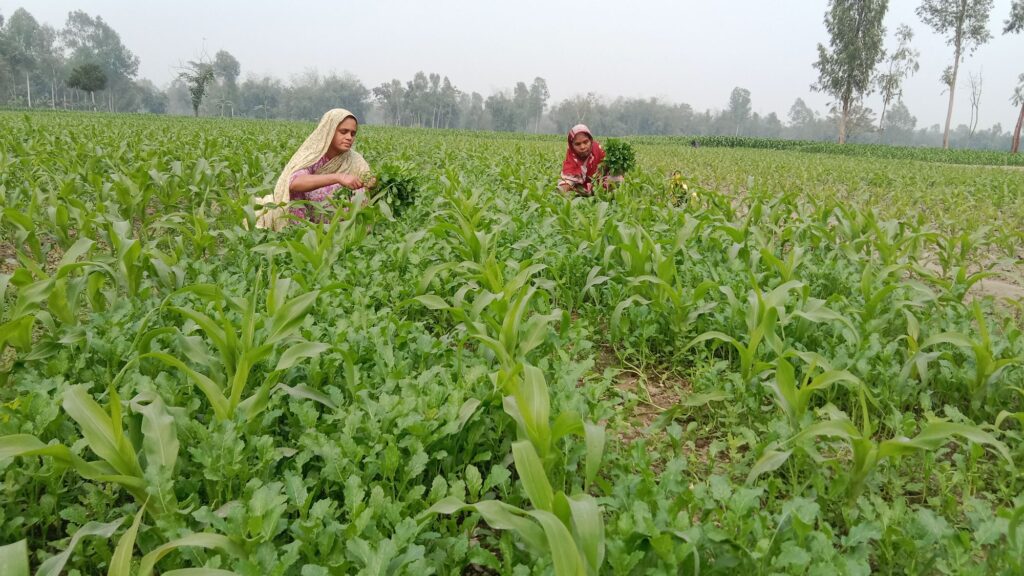
In southern coastal Bangladesh, where aman rice is the primary crop, there is a significant need for crop intensification through diverse cropping systems. Implementing short-duration aman rice varieties can facilitate earlier harvests, creating opportunities for subsequent crop cycles. However, there are challenges associated with these short-duration varieties in the region. Additionally, cultivating less water-intensive crops such as groundnut, mungbean, maize, and sunflower provides a viable strategy to enhance production during the rabi season. These crops are not only more resilient to salinity and water shortages but also offer greater economic returns. Establishing water reservoirs can help store monsoon runoff for supplemental irrigation, which mitigates dry-season water scarcity. Furthermore, sorjan (raised bed) systems enable vegetable cultivation on elevated beds while utilizing trenches for fish, optimizing land use in waterlogged and saline areas.
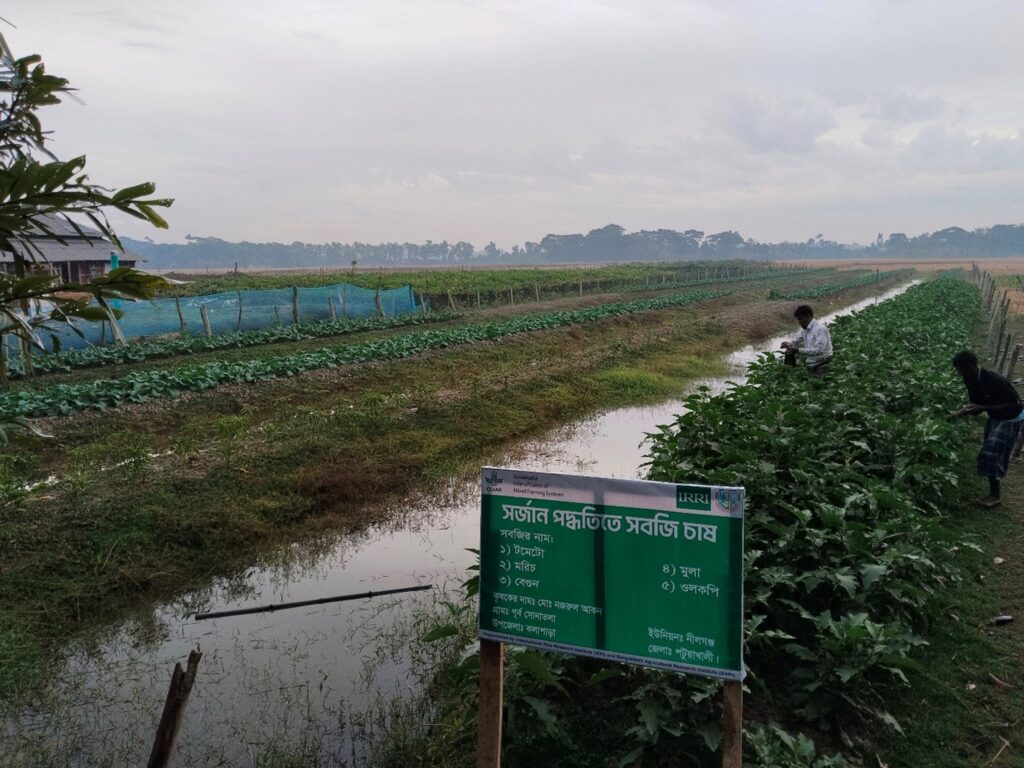
Strategies for sustainable diversification in Bangladesh
Bangladesh’s agricultural sector must balance crop intensification and diversification to enhance productivity without degrading soil fertility. While intensification boosts yields, excessive pressure on land can lead to nutrient depletion, soil erosion, and reduced long-term sustainability. Therefore, judicious crop intensification must integrate ecological practices that maintain soil health. Key strategies include intercropping with leguminous crops, cover cropping, green manuring, and agroforestry, each contributing uniquely to sustainable diversification.
Intercropping with Leguminous Crops: Intercropping of different leguminous crops, such as mungbean, cowpea, and soybean, etc. with maize and potato enhances soil nitrogen through biological fixation, reducing dependency on synthetic fertilizers.
Cover cropping: Cover cropping involves planting crops to improve growing conditions rather than obtaining a harvest. Cover cropping serves as a protective measure that reduces evaporation, prevents soil erosion, and enhances soil structure, while also providing organic matter to nourish the soil. Cover crop is also used to suppress weed growth. Farmers may plant different leguminous crops as a cover crop.
Green Manuring: Green manuring is the practice of growing specific crops, typically fast-growing legumes, and then plowing them back into the soil while they are still green. This organic matter decomposes and enriches the soil with nutrients, particularly nitrogen. It also improves soil structure and enhances microbial activity. Between two rice crops (during the fallow period), farmers can cultivate dhaincha (sesbania), sunn hemp, etc., as green manure crops.
Agroforestry: Agroforestry enhances crop diversification in rice-based systems by integrating trees with traditional rice cultivation. By planting fruit trees (such as mango and litchi), timber species, or nitrogen-fixing trees (like Leucaena and Gliricidia) along field borders or in rotational patterns, farmers can create a multi-layered farming system. This approach provides additional harvests, including fruits and fodder, improves soil fertility through nitrogen fixation and organic matter from leaf litter, and reduces climate risks by offering alternative income sources if rice yields fail.
The path toward diversified cropping systems in Bangladesh is not without its hurdles, but the potential benefits are immense. By prioritizing sustainable farming practices, Bangladesh can enhance food security, increase farmer resilience, and combat the adverse effects of climate change. These strategies collectively foster an environmentally sustainable agricultural framework that not only boosts productivity but also conserves vital soil resources, ensuring long-term food security in Bangladesh.
The CGIAR initiative Mixed Farming System (MFS) has been implemented in Bangladesh from 2022 to 2024, and several innovations developed from this initiative will continue in the CGIAR’s new Science program “Sustainable Farming.”
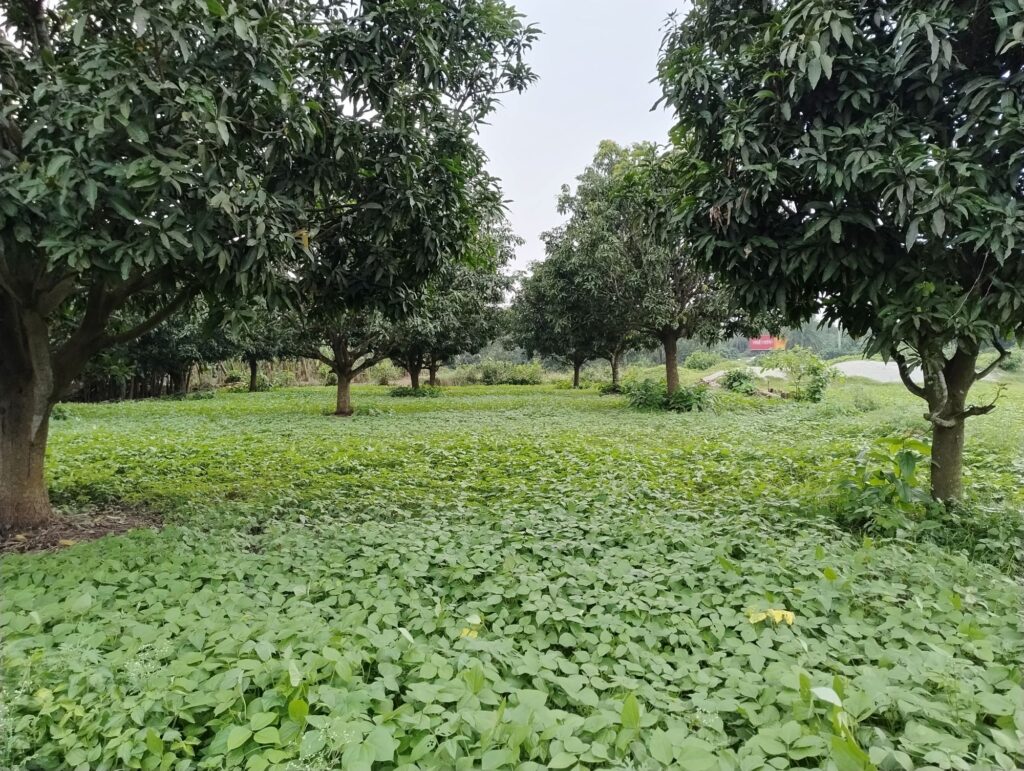
References
Nasim, M., Shahidullah, S., Saha, A., Muttaleb, M., Aditya, T., Ali, M., Kabir, M., 2018. Distribution of Crops and Cropping Patterns in Bangladesh. Bangladesh Rice Journal 21. https://doi.org/10.3329/brj.v21i2.38195

